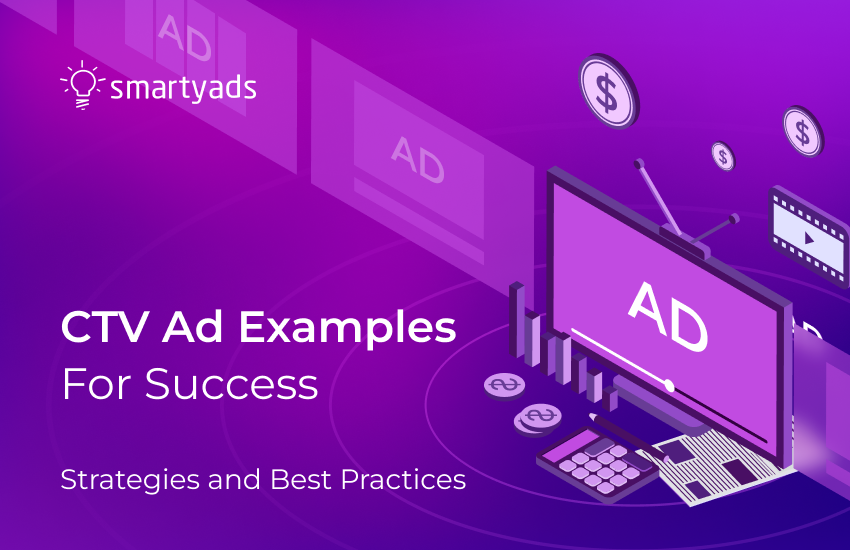Do you watch TV a lot? Do you have a traditional linear TV or a smart TV? What about shows on Netflix or HBO? And YouTube videos or streams on Twitch? If any of these are on your list of enjoyable pastimes, then you are part of those 110 million CTV users that CTV advertising can reach.
Connected TV advertising is a very common and useful tool for marketers of any brand. With a record 92 percent of households in the U.S. having access to CTV devices, Connected TV advertising is one of the most versatile advertising instruments.
In today's ever-evolving landscape, where the persisting pandemic continues to shape consumer behaviors, there has been a significant surge in the popularity of streaming services.
Along with this trend, the availability of a rich selection of premium content has fueled the growth of Connected TV (CTV) to become the fastest-growing advertising platform, as Forbes noted.
Linear TV advertising is rapidly losing ground. As marketers and advertisers strive to stay ahead of the curve in this dynamic environment, it's important to recognize the huge potential that advertising on Сonnected TV offers.
With its broad reach and engaging content, CTV offers a unique opportunity to connect with audiences meaningfully and effectively.

How Does Connected TV Advertising Work?
Connected TV advertising operates within the digital advertising landscape through an Internet connection, leveraging devices such as smart TVs, streaming devices (e.g., Roku, Apple TV), gaming consoles, and mobile apps to deliver targeted ads to viewers.
In order to run Connected TV ads, you need to use a platform that will allow you to do so. Nowadays, the most relevant platforms of this type are programmatic platforms. For example, SmartyAds DSP is one such platform.
Programmatic platforms use automated systems and algorithms to simplify the buying and selling of advertising inventory in real time. Advertisers can target specific audience segments, set bidding strategies, and optimize their campaigns for better performance.
With programmatic platforms, you gain the ability to gather valuable data about your target audience and their behaviors. Programmatic platforms enable you to access comprehensive analytical reports on your campaign's performance, providing insights that drive informed decision-making.
Furthermore, programmatic advertising empowers you to make timely adjustments to your campaign, ensuring you can optimize and refine your strategies as needed. The flexibility and data-driven nature of programmatic platforms offer a powerful toolset for maximizing the effectiveness and success of your advertising campaigns.
What sets CTV advertising apart from OTT advertising?
Let's clarify a common misconception in terms. Many marketers mistakenly consider CTV and OTT interchangeable, but they are distinct concepts.
OTT, or Over-the-Top, refers to the delivery of video content over the Internet, bypassing the traditional distribution methods of cable, satellite, and broadcast television. Major OTT providers include popular platforms like Netflix, Hulu, Amazon Prime Video, Disney+, etc.
These platforms have revolutionized how people consume entertainment, offering an extensive library of on-demand movies, TV shows, documentaries, and original series, empowering viewers to watch what they want, whenever they want.
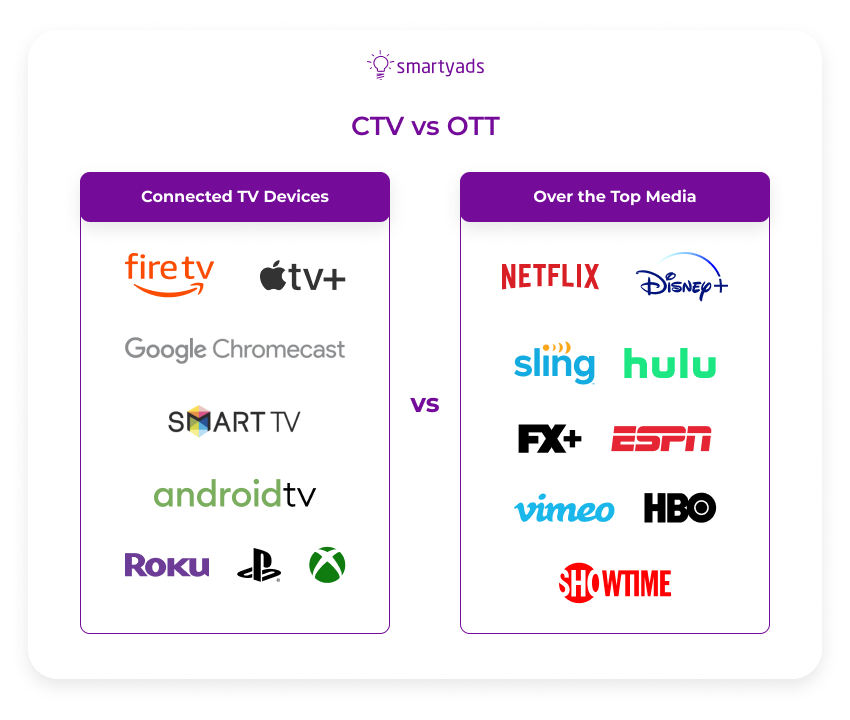
Conversely, CTV, or Connected TV, means the equipment used to access and broadcast OTT content to a TV screen. CTV devices include smart TVs, streaming media players like Roku, Amazon Fire TV, Apple TV, gaming consoles, and even certain set-top boxes.
These devices provide users with a user-friendly interface and easy access to a wide range of OTT apps. CTV has achieved significant traction over the years as consumers seek more flexibility and control over their viewing experience.
The convenience of accessing OTT content on large screens has made CTV a popular choice for a large number of households, contributing to the decline of traditional TV subscriptions.
So, CTV advertising is limited to TV screens, while OTT advertising extends across various devices like smartphones and PCs. Both offer precise targeting, but OTT advertising has more mature analytics. CTV's advertising inventory is more limited, while OTT advertising provides a broader variety of choices.
Connected TV Advertising: Short Guide
It really doesn't take much to create a quality Connected TV ad. In fact, it's no different than creating any other quality ad these days. However, let us still break down the key steps for getting the perfect ad that will attract your desired target audience.
Research your audience
Yes, yes, you've heard this somewhere before (just about everywhere). But unfortunately or fortunately, it's a rule you can't avoid with Connected TV advertising. If you don't know your customers, you won't be able to offer them the product they need. So don't be lazy and analyze all available data on your audience.
Use interactivity
Interactive TV ads are most often video ads, and they provide a huge number of opportunities to create interactivity with users. Take advantage of this opportunity to create ads that will stand out from all others.
Don't bore the viewer
TikTok, Instagram Shorts, YouTube Shorts, Stories, Twitter — all of these social networks have nurtured an audience for us that doesn't really like to waste time on something that is unspecific and doesn't grab them instantly.
The optimal length for Connected TV advertising is 15-30 seconds, which is exactly how long viewers are willing to spend to give your ad a chance to be seen and heard.
Use trusted platforms
Unfortunately, ad fraud remains one of the most common types of scams. Therefore, using a trusted platform with sufficient credibility is crucial, providing a transparent approach and security guarantee to launch your Connected TV ad campaign.
Use Metrics
You may have the perfect creative, the perfect target audience, and the perfect platform to launch your ads, but that doesn't mean you have the right to relax. Connected TV advertising can be unpredictable, and sometimes it brings pleasant surprises, and sometimes it ruins reputations.
So don't forget to check the connected TV measurement of the campaign after the launch and make changes to the settings if necessary.
Connected TV ads components and its impact on advertisers
Broadcast TV
Prominent streaming services like Hulu, Disney+, and Netflix offer exclusive content to viewers. Advertisers can use these platforms to reach a wide audience and align their ads with popular shows or movies.
CTV-Enabled Devices
Devices such as Roku and Amazon Fire TV Stick enable streaming content on televisions, providing a seamless viewing experience for users. Advertisers can leverage these devices to deliver targeted ads directly to the big screen.
Smart TVs
Brands like Samsung, LG, and TCL incorporate streaming capabilities into their televisions, allowing viewers to access content without additional devices. Advertisers can target viewers through these smart TVs to maximize their reach and impact.
Mobile Measurement Partners (MMP)
MMPs are crucial in measuring campaign performance accurately and combating fraudulent activities. They provide advertisers with valuable insights into ad viewability, engagement metrics, and campaign effectiveness, ensuring transparency and data-driven decision-making.
SSP Platform (Supply Side Platform)
SSPs act as technology platforms that manage the distribution of publishers' ads across multiple ad exchanges. They handle tasks such as selling ad space, optimizing deals, and measuring campaign performance. SSPs enable publishers to maximize their revenue and provide inventory for advertisers to reach their desired audiences effectively.
DSP Platform (Demand Side Platform)
DSPs offer advertisers a single interface for buying ad space and accessing inventory. These platforms drive the efficient purchase of ad impressions by allowing advertisers to target specific audiences and optimize campaigns based on cost per thousand impressions (CPM). DSPs optimize the ad buying process and allow advertisers to make data-based decisions.
Various data sources in the advertising landscape collect data in unique ways, leading to distinct insights. However, it's important to note that many of these sources operate within closed walled garden platforms.
This means that advertisers often have to engage directly with these platforms, resulting in fragmented and restricted data sets. User-level data tends to remain within these closed platforms, limiting advertisers' access to comprehensive and holistic data.
Connected TV monetization models
Now that we've covered how Connected TV works, let's talk about money. There are four main monetization models you should know about.
Subscription Video on Demand (SVOD)
This widely adopted model requires users to pay a recurring subscription fee, typically monthly or annual, in exchange for unlimited access to video content. Leading platforms like Netflix, Amazon Prime, and Disney+ utilize this model. To retain and expand their viewer base, OTT and CTV providers must consistently offer fresh and exclusive content.
Advertising Video on Demand (AVOD)
AVOD relies on the strategic placement of pre-roll, mid-roll, or post-roll ads within video content. In addition to video ads, publishers can leverage banner ads, sponsorships, and paid promotions to generate revenue, reducing reliance on subscription fees. Advertisers benefit from the ability to reach engaged audiences while viewers access free content supported by ads.
Transactional Video on Demand (TVOD)
TVOD allows users to make individual purchases or rentals for specific video content. Platforms like iTunes and Google Play utilize this model, enabling users to buy or rent movies, TV shows, or live events on a pay-per-view basis. This model appeals to viewers seeking specific content and offers flexibility for occasional viewership.
Hybrid Models
Some platforms adopt hybrid monetization models that combine multiple approaches. For example, a platform may offer subscription-based access to a vast library of content (SVOD) and also include some ads or pay-per-view options (AVOD/TVOD) for exclusive or premium content.
These models provide viewers and content providers with flexibility, allowing for a diversified revenue stream.
Streaming TV vs. Connected TV
Streaming TV and Connected TV are not opposed to each other, as one is essentially part of the other. However, a lot of people confuse the two, and there are still differences between them that should be understood, and we will talk about them now.
Streaming TV
Streaming TV, also known as streaming video on demand (SVOD), refers to the delivery of television content over the Internet connection to a variety of streaming devices, such as smartphones, tablets, computers, and smart TVs. Streaming video service like Netflix, Hulu, Amazon Prime Video, Disney+, and many others, offers a wide range of on-demand TV shows, movies, documentaries, and original content.
Users can access these services through dedicated apps or websites and stream content conveniently. It allows for greater flexibility, as viewers can choose what they want to watch and when they want to watch it, often without the need for a traditional TV subscription. Read how SmartyAds partners with GumGum and why it is also benefitial for connected TV traffic.
Connected TV
Connected TV, also known as a smart TV, refers to a television set with Internet connectivity and built-in software or apps to access online content. Connected TVs eliminate the need for external devices, such as streaming boxes or media players, to access streaming services or other online content.
They typically have an operating system or platform (e.g., Apple TV, Android TV, webOS, Tizen) that provides access to various apps and streaming services directly on the TV. Connected TVs often offer additional features like web browsing, social media integration, and screen mirroring from compatible devices.

Best Connected TV advertising examples
We talk so much about Connected TV advertising you've probably been curious to see how Connected TV advertising works for different brands. Let's take a look at some of the best Connected TV ad examples.
Meineke
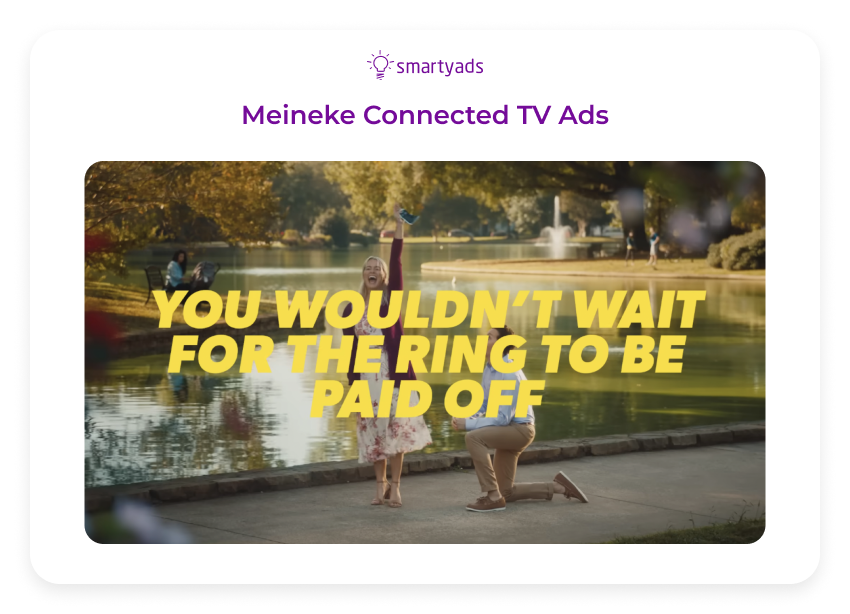
Meineke, an auto repair company, faced challenges measuring the effectiveness of its digital media strategy. Implementing a strategic Connected TV campaign targeting premium audiences during NHL and NFL games resulted in a remarkable 63% higher conversion rate for live sports ads, with 48,000 in-store visits in two months.
The ads outperformed linear TV by over 180% in the 18-34 age bracket, showcasing the immense potential of targeted Connected TV advertising.
GumGum
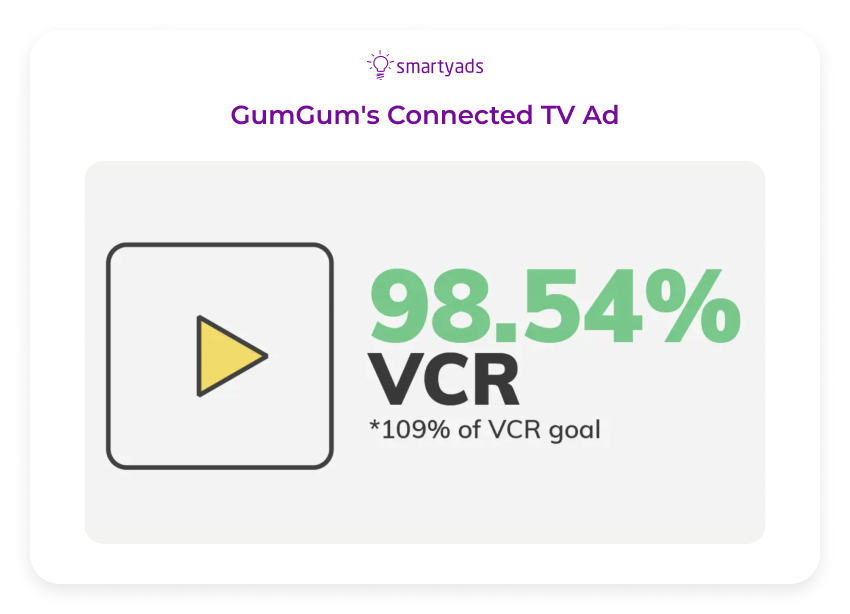
GumGum recently partnered with IRIS.TV, a robust video platform, to elevate the video experience for a jewelry company. By leveraging GumGum and IRIS.TV, they successfully drove a robust VCR metric. PMP video programs were used to target contextually relevant videos in the areas of fashion, parenting, shopping, etc. In addition, a customized segment dedicated to Mother's Day was created specifically for the advertiser.
The results were exceptional. GumGum and IRIS.TV surpassed the client's expectations, achieving an impressive VCR of 98.54%. The Verity™ Video PMP campaign also outperformed two other CTV providers utilized by the advertiser, boasting a higher VCR than both and a lower CPM than one of them. This collaboration exemplifies the effectiveness of GumGum and IRIS.TV in driving impactful video campaigns for their clients.
Volvo
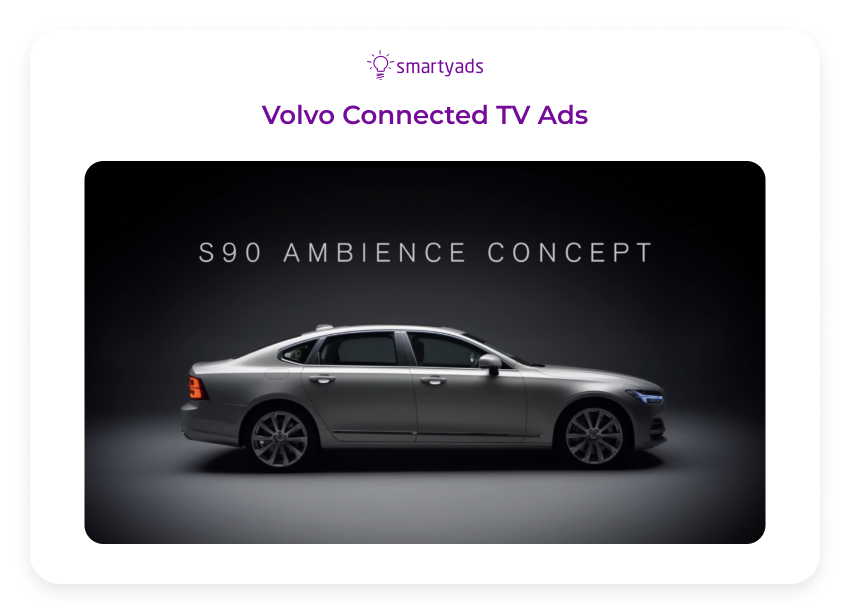
Volvo's latest S90 model was introduced through a strategic approach, utilizing interactive CTV ads exclusively designed for Roku and Samsung streaming devices.
By leveraging the potential of interactive CTV ads on popular platforms like Roku and Samsung, Volvo successfully showcased its latest S90 model. These engaging ads allowed viewers to virtually explore the vehicle inside and out while receiving personalized messages that guided them to the nearest Volvo dealership.
The interactive nature of the ads not only provided viewers with a comprehensive understanding of the purchase journey but also generated a sense of urgency, interactivity, and captivation.
As a result, Volvo witnessed a remarkable 35% increase in sales, highlighting the effectiveness of these interactive CTV ads in driving consumer engagement and conversions.
Subway
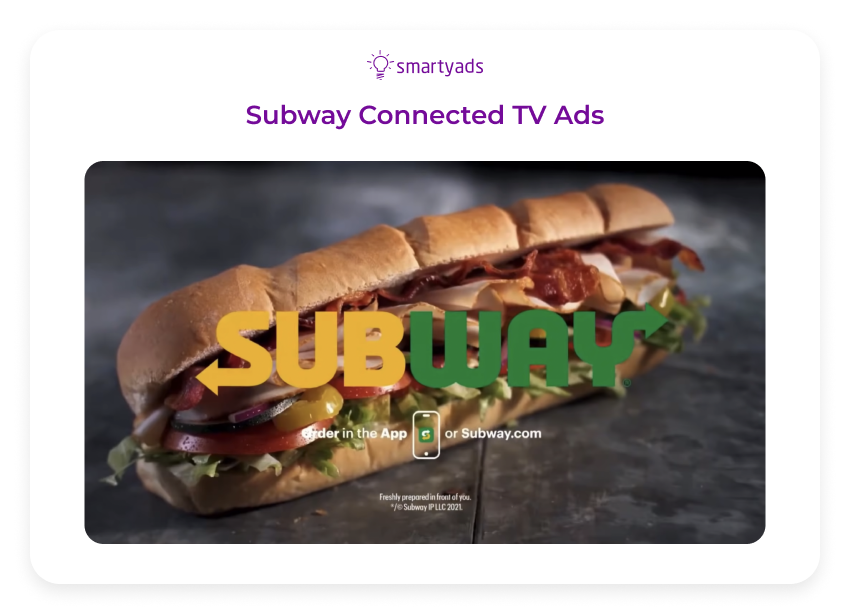
Subway, the sandwich giant, partnered with superstar celebrities like Tom Brady and Serena Williams to boost brand recognition and excitement for their latest menu additions.
The influential stars introduced enticing new menu items, including bread options, seasonings, and ingredients. They also unveiled an exciting 50-sub giveaway at each Subway location.
The campaign's success was remarkable, with the top quartile restaurants experiencing a 33% surge in sales and the highest weekly unit volume in over eight years. This widely acclaimed campaign is one of Subway's most significant media investments.
Fiverr
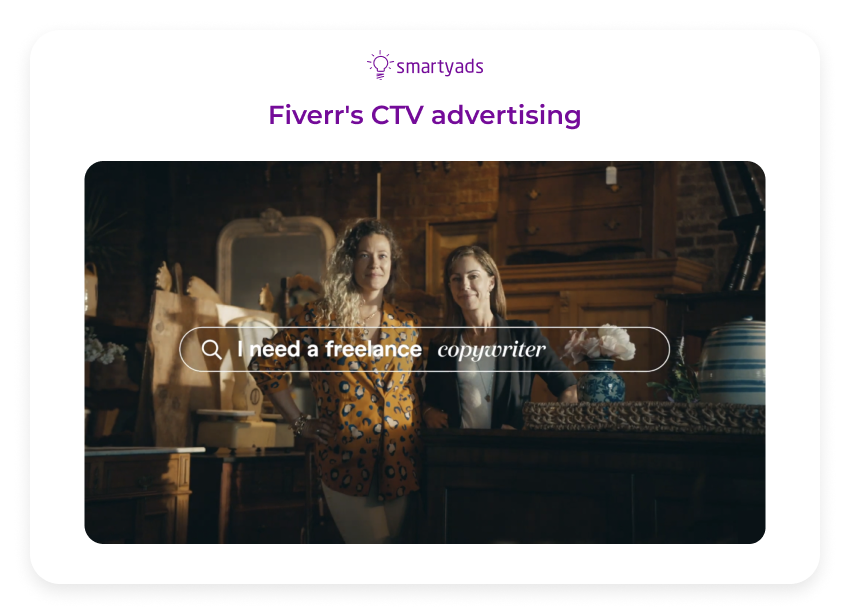
Fiverr's Connected TV ad campaign spotlights resilient small businesses that have thrived during challenging economic times. By showcasing the dedication and resourcefulness of these entrepreneurs, the campaign inspires others to pursue their business goals with determination.
The "It Starts Here" campaign includes concise video ad spots on digital streaming channels, social media, and national U.S. television. Fiverr also engages its audience through longer YouTube videos and captivating Instagram stories to foster deeper connections with the showcased brands.
Alongside the campaign, Fiverr undergoes a brand identity evolution, retaining its core essence while visually representing its transformative impact on the global work landscape.
The fresh logo, expanded color palette, unique wordmark, and vibrant imagery celebrate the creativity and enthusiasm of the Fiverr community, which remains at the heart of the company's community-centric approach.
Key takeaways
CTV advertising is on the same level as banner ads because it can reach almost any user from any audience segment. And if you use it wisely, it will benefit you greatly.
Don't forget the main point in creating such ads:
- Be creative;
- Don't forget about interactivity;
- Don't bore your users;
- Talk about the brand;
- Analyze and optimize.
Create the most effective CTV campaigns with SmartyAds DSP!

